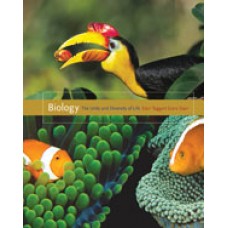Test Bank for Biology The Unity and Diversity of Life, 12th Edition
$35.00 Original price was: $35.00.$26.50Current price is: $26.50.
Test Bank for Biology The Unity and Diversity of Life, 12th Edition
Test Bank for Biology The Unity and Diversity of Life, 12th Edition
Product details:
Starr, Cecie Starr, Ralph Taggart, Taggart, Christine Evers, Lisa Starr
By using an issues-oriented approach, the new edition of this respected text grabs student interest with real-life issues that hit home. This text includes new coverage and pedagogy that encourages students to think critically about hot-button issues and includes outstanding new features that take students beyond memorization and encourage them to ask questions in new ways as they learn to interpret data. Show students how biology matters – Biology’s connections to real life are reflected in every chapter of this new edition, beginning with opening Impacts,Issues essays�a brief case study on a biology-related issue or research finding and is revisited throughout the chapter, reminding students of the real-world significance of basic concepts. Additional, online exercises promote critical thinking about issues students will face as consumers, parents, and citizens. Link concepts from chapter to chapter – Links to Earlier Concepts appear near the Key Concepts, to help students remember what they’ve learned in earlier chapters and apply it to the new material to come. At the beginning of each section, students are reminded of the earlier link that is most appropriate for their current study.
Table of contents:
1. Invitation to Biology. UNIT I PRINCIPLES OF CELLULAR LIFE.
2. Life’s Chemical Basis.
3. Molecules of Life.
4. Cell Structure and Function.
5. A Closer Look at Cell Membranes.
6. Ground Rules of Metabolism.
7. Where It Starts�Photosynthesis.
8. How Cells Release Chemical Energy. UNIT II PRINCIPLES OF INHERITANCE.
9. How Cells Reproduce.
10. Meiosis and Sexual Reproduction.
11. Observing Patterns in Inherited Traits.
12. Chromosomes and Human Inheritance.
13. DNA Structure and Function.
14. From DNA to Protein.
15. Controls Over Genes.
16. Studying and Manipulating Genomes. UNIT III PRINCIPLES OF EVOLUTION.
17. Evidence of Evolution.
18. Processes of Evolution.
19. Organizing Information About Species.
20. Life’s Origin and Early Evolution. UNIT IV EVOLUTION AND BIODIVERSITY.
21. Viruses and Prokaryotes.
22. “Protists”�The Simplest Eukaryotes.
23. The Land Plants.
24. Fungi. 25 Animal Evolution�The Invertebrates.
26. Animal Evolution�The Chordates. 27 Plants and Animals�Common Challenges. UNIT V HOW PLANTS WORK.
28. Plant Tissues.
29. Plant Nutrition and Transport.
30. Plant Reproduction.
31. Plant Growth and Development. UNIT VI HOW ANIMALS WORK.
32. Animal Tissues and Organ Systems.
33. Neural Control.
34. Sensory Perception.
35. Endocrine Control.
36. Structural Support and Movement.
37. Circulation.
38. Immunity.
39. Respiration.
40. Digestion and Human Nutrition.
41. Maintaining the Internal Environment.
42. Animal Reproductive Systems.
43. Animal Development. UNIT VII PRINCIPLES OF ECOLOGY.
44. Animal Behavior.
45. Population Ecology.
46. Community Structure and Biodiversity.
47. Ecosystems.
48. The Biosphere.
49. Human Impacts on the Biosphere.
People also search:
biology the unity and diversity of life pdf
biology the unity and diversity of life quizlet
Related products
Test Bank
Test Bank for Operating Systems: Internals and Design Principles, 7th Edition: William Stallings












